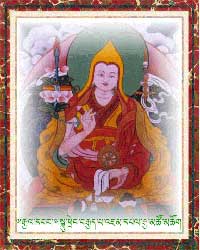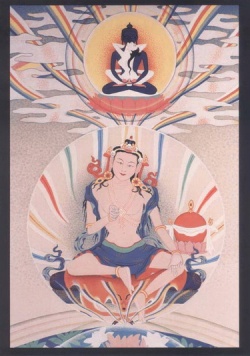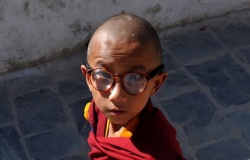The 8th Dalai Lama and the Golden Urn
During the tenure of the 7th Dalai Lama, Tibet became a protectorate of the Qing Dynasty of China. For several years, a Tibetan aristocrat and general named Pholhane ruled Tibet, with Qing support. The 7th Dalai Lama was given only ceremonial duties, when he was allowed to reside in Lhasa at all.
After Philhane died he was succeeded by a son, but the son was assassinated by the Qing representatives in Lhasa, called ambans. Violence ensued; the Qianlong Emperor sent troops to Lhasa to restore order.
However, instead of seizing control of Tibet, the Qianlong Emperor allowed the 7th Dalai Lama, then 43 years old, to assume the position of head of Tibet's government. New ambans were left in Lhasa to act as the Emperor's eyes and ears.
The 7th Dalai Lama never assumed autocratic control of Tibet. He co-ruled with a council of four Tibetan ministers called the Kashag. Plus, other ministers, the heads of other schools of Buddhism, and the Panchen Lama all had a say in how Tibet was governed.
The 7th Dalai Lama died in 1757.
Early Life of the 8th Dalai Lama
The boy who would become His Holiness Jamphel Gyatso, the 8th Dalai Lama, was born in southwest Tibet in 1758. While still an infant, he was recognized as the Dalai Lama's tulku by the 6th Panchen Lama. At age 2 1/2 he was taken to Tashilhunpo Monastery, about 160 miles southwest of Lhasa, to begin training. At the age of 4 he was escorted to Lhasa and enthroned in Potala Palace as the 8th Dalai Lama.
Jamphel Gyatso was represented in government by a series of regents until 1784, when he was 26. This was much later than other Dalai Lamas had assumed responsibility. But by all accounts, Jamphel Gyatso was disinterested in government and preferred to let others run Tibet. In 1790 he returned governing duties to his regent, who had been acting as an ambassador to the Emperor's court in Beijing.
The 8th Dalai Lama's mark on history was small enough that some histories of Tibet do not mention him at all. Even so, some significant events happened during his tenure that pertain to Tibet's situation today.
A Family Spat
The 6th Panchen Lama had two brothers who also were reincarnated high lamas, the Shamar tulku and the Trungpa tulku of the Kagyu school. Another sibling, a sister, also was recognized as a tulku.
In 1780 the 6th Panchen Lama died from smallpox while on a state visit to Beijing. The distraught Qianlong Emperor heaped the Panchen Lama's entourage with costly presents to take back to Tibet. The Trungpa tulku, who had been traveling with his brother, received the presents and stored them in Tashilhunpo, where he was the treasurer.
The Shamar tulku objected, saying that the gifts had been given to the family, not to a monastery. He demanded a share of the presents. When Trungpa refused, the Shamar tulku organized Kagyu monks and stormed Tashilhunpo, taking a portion of the Emperor's gifts.
The Shamar tulku's act did not sit well with authorities. The presents were taken back to Tashilhunpo, and the Shamar tulku was ordered confined to his monastery. He fled to Nepal, which recently had been conquered by Gurkhas.
Gurkhas Invade Tibet
The Gurkhas had already been stirring up issues about coinage and trade with Tibet, probably building an excuse to invade. The Gurkhas informed the Kashag in Lhasa they were holding the Shamar tulku hostage until certain demands were met. But the Kashag expressed disinterest in getting the Shamar tulku back.
In 1789 Gurkha troops entered Tibet and marched toward Tashilhunpo, possibly at the request of the Shamar tulku, who was not really a hostage. The ambans of Lhasa sent word to the Qianlong Emperor. The Emperor sent troops to the border of Tibet but was loathe to take on the Gurkhas. He encouraged the Tibetans and Gurkhas to make a deal.
The deal that was made quickly fell apart. In 1790 the Gurkhas invaded Tibet again. This time they seized several provinces and looted Tashilhunpo. Panic gripped Lhasa; as others prepared to flee, the 8th Dalai Lama addressed the people from a balcony of Potala Palace and promised he would remain in Lhasa.
The Tibetan army moved against the Gurkhas and cut off their supply lines. But then a massive force of 17,000 Chinese troops arrived, led by one of the Qianlong Emperor's best generals. The Gurkhas were pursued deep into Nepal and forced to surrender. The loot from Tashilhunpo was recovered and sent back to Beijing. By then the Shamar tulku had died -- it is not certain how -- and his lineage would not be restored until the 20th century.
The Golden Urn
The Qianlong Emperor blamed the conflict between the Gurkhas and Tibetans on the altercation between the Shamar tulku and Trunpa tulkus. The fact that so many high lamas had been found within the same influential family smacked of favoritism, he thought. The Emperor decided such concentrations of influence needed to be broken up.
So, the Emperor's Manchu general, still accompanied by 17,000 troops, negotiated new regulations with the government of Tibet. The first of these involved the golden urn. From that time on, the regulation said, high lamas would be chosen by a kind of lottery by drawing slips from the urn.
How much was the golden urn lottery really used? It's hard to say. It's generally agreed the urn was used to choose the 10th Dalai Lama, but its use had been discontinued by the time the 13th Dalai Lama was chosen. The Tibetans never liked it and preferred their own mystical process.
Now, we have to do a quick fast forward to the present day. The current government of the People's Republic of China has reinstated the golden urn lottery, insisting that is the only legitimate way Dalai and Panchen lamas may be chosen.
In 1995, the newly identified 11th Panchen Lama, a six-year-old boy named Gedhun Choekyi Nyima, disappeared along with his family. Beijing makes vague statements about the family living on a farm somewhere, but since no one has seen them since 1995 it is assumed they are either imprisoned or dead. Beijing held a golden urn lottery to choose another boy, the son of a Tibetan Communist Party official, to become the new Panchen Lama. Beijing has made it clear that when the 14th Dalai Lama dies, this faux Panchen Lama will officiate at the golden urn ceremony that will choose a faux 15th Dalai Lama.
It's unclear what Beijing hopes to accomplish, since it's unlikely anyone outside of China will take the Chinese Communist Party's choice of Dalai Lama seriously. But that's the plan.
The 8th Dalai Lama's Later Life and Successors
The 8th Dalai Lama is remembered for completing the construction of Norbulingka Park and Summer Palace, begun by the 7th Dalai Lama. He died in 1804. The next four Dalai Lamas -- the 9th, 10th, 11th, and 12th -- all died young. Not until the Great Thirteenth, Thubten Gyatso (1876-1933) , would a Dalai Lama become a significant figure in history.



